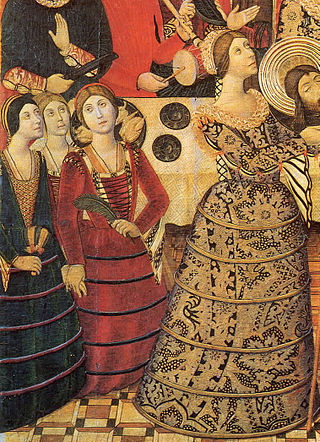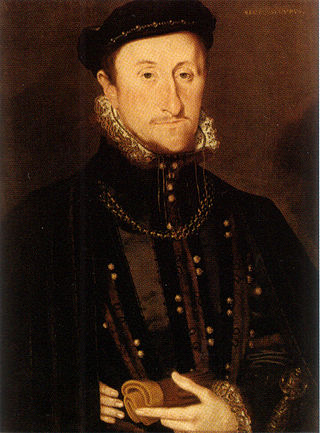Related Research Articles

A farthingale is one of several structures used under Western European women's clothing - especially in the 16th and 17th centuries - to support the skirts in the desired shape and to enlarge the lower half of the body. The fashion originated in Spain in the fifteenth century. Farthingales served important social and cultural functions for women in Renaissance Europe as they expressed, primarily when worn by court women, high social position and wealth.

James Hamilton, 1st Duke of Châtellerault, 2nd Earl of Arran, was a Scottish nobleman and head of the House of Hamilton. A great-grandson of King James II of Scotland, he was heir presumptive to the Scottish throne. Arran was Regent of Scotland during the minority of Mary, Queen of Scots from 1543 to 1554, when he lost the regency to Mary of Guise. At first pro-English and Protestant, he converted to Catholicism in 1543 and supported a pro-French policy. He reluctantly agreed to Mary's marriage to Francis, eldest son of King Henry II of France, and was rewarded by Henry by being made Duke of Châtellerault in 1549. During the Scottish Reformation, Châtellerault joined the Protestant Lords of the Congregation to oppose the regency of Mary of Guise, and lost his French dukedom as a result.
The Treasurer was a senior post in the pre-Union government of Scotland, the Privy Council of Scotland.
Anne Hamilton, Countess of Huntly, was a Scottish noblewoman and a member of the powerful Hamilton family which had a strong claim to the Scottish crown. Her father James Hamilton, Duke of Châtellerault, 2nd Earl of Arran was heir presumptive to the throne of Scotland after Mary, Queen of Scots prior to the birth of the latter's son Prince James in 1566. Anne was the wife of George Gordon, 5th Earl of Huntly, Lord Chancellor of Scotland and a chief conspirator during the reign of Queen Mary.

Kinneil House is a historic house to the west of Bo'ness in east-central Scotland. It was once the principal seat of the Hamilton family in the east of Scotland. The house was saved from demolition in 1936 when 16th-century mural paintings were discovered, and it is now in the care of Historic Environment Scotland. The house now consists of a symmetrical mansion built in 1677 on the remains of an earlier 16th- or 15th-century tower house, with two rows of gunloops for early cannon still visible. A smaller east wing, of the mid 16th century, contains the two painted rooms. The house is protected as a Category A listed building.
John Tennent or Tennand of Listonshiels was a servant and companion of King James V of Scotland. He kept an account of the king's daily expenses which is an important source document for the Scottish royal court.
John Drummond of Milnab was a 16th-century Scottish carpenter in charge of the woodwork of the palaces, castles and guns of James IV of Scotland and James V of Scotland.
Robert Sempill, 3rd Lord Sempill was a Scottish lord of Parliament.
Nichola or Nicolle was a fool or jester to Mary, Queen of Scots.

Margaret Stewart, Lady Gordon was the daughter of James IV of Scotland and his mistress Margaret Drummond.

Robert Gourlay or Robin Gourlaw was a wealthy Edinburgh merchant and Customar of Edinburgh who built a renowned house in Edinburgh.
Sir William Hamilton of Sanquhar was pursemaster for James V and the Captain of Edinburgh Castle during the Regency of Regent Arran.

Friar Mark Hamilton was a Scottish Dominican and author of a History of the Hamiltons. His kinsman Regent Arran gave Friar Mark Hamilton £4 Scots for a friar's habit on 20 September 1553. Apart from his History and the record of the gift of a habit, few other details of Friar Mark's life are known.
Barbara Hamilton was a Scottish courtier.

The wardrobe of Mary, Queen of Scots, was described in several contemporary documents, and many records of her costume have been published.

Thomas Arthur was a Scottish tailor who worked for James V of Scotland.

Robert Hamilton of Briggis was a Scottish soldier and military engineer. He was keeper of Linlithgow Palace and Dunbar Castle and was Master of the Scottish artillery.

James Barroun or Baron was a wealthy Scottish merchant based in Edinburgh and supporter of the Scottish Reformation.
Margaret Douglas, Countess of Arran and Duchess of Châtellerault was a Scottish aristocrat.

A safeguard or saveguard was a riding garment or overskirt worn by women in the sixteenth and seventeenth centuries. Some safeguards were intended to protect skirts or kirtles worn beneath. Mary Frith, dramatised as the character Moll Cutpurse in The Roaring Girl, wore a black safeguard over breeches.
References
- ↑ Melanie Schuessler Bond, Dressing the Scottish Court 1543-1553: Clothing in the Accounts of the Lord High Treasurer of Scotland (Boydell, 2019), pp. 384, 657-8.
- ↑ James Balfour Paul, Accounts of the Treasurer of Scotland, vol. 10 (Edinburgh, 1913), p. xiv.
- ↑ Melanie Schuessler Bond, 'Social Status in Sixteenth-Century Scottish Fashion', Cordelia Warr, Medieval Clothing and Textiles 18 (2024), pp. 165–190.
- ↑ Melanie Schuessler Bond, Dressing the Scottish Court 1543-1553: Clothing in the Accounts of the Lord High Treasurer of Scotland (Boydell, 2019), pp. 392, 396, 398, 460.
- ↑ Melanie Schuessler Bond, Dressing the Scottish Court 1543-1553: Clothing in the Accounts of the Lord High Treasurer of Scotland (Boydell, 2019), pp. 104, 395, 400.
- ↑ Melanie Schuessler Bond, Dressing the Scottish Court 1543-1553: Clothing in the Accounts of the Lord High Treasurer of Scotland (Boydell, 2019), p. 400.
- ↑ Melanie Schuessler Bond, Dressing the Scottish Court 1543-1553: Clothing in the Accounts of the Lord High Treasurer of Scotland (Boydell, 2019), p. 400.